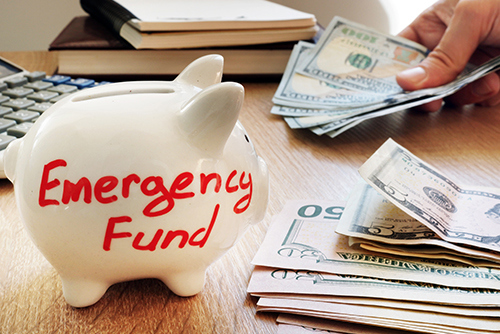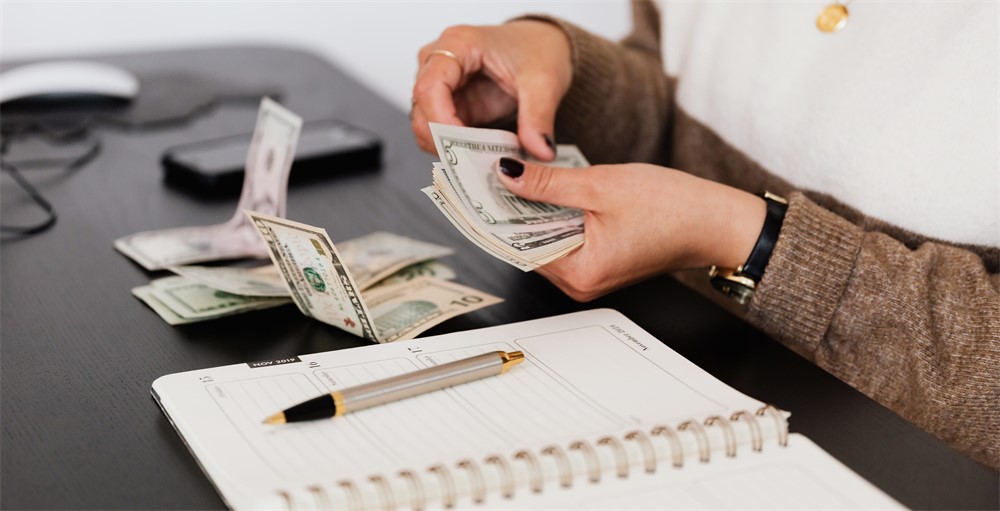What Is An Emergency Fund & Why You Need One
An emergency fund is essential for financial security. Learn what it is, why you need one, and simple steps to start saving for unexpected expenses today.

Michael J. Harrington
Mar 26, 2025
Life has a funny way of throwing unexpected challenges at us when we least expect them. A sudden job loss, a medical emergency, or a major car repair can quickly turn your financial situation upside down. This financial uncertainty is precisely why having an emergency fund is not just recommended it's essential for your financial well-being.
An emergency fund serves as your financial safety net, giving you peace of mind and protection against life's unpredictable moments. It's a foundational element of financial stability that can make the difference between weathering a crisis smoothly or falling into debt.
What Is An Emergency Fund?
An emergency fund is a dedicated amount of money set aside specifically to cover unexpected expenses or financial emergencies. Unlike other savings accounts earmarked for specific goals like buying a home or retirement, an emergency fund exists solely to help you navigate unforeseen financial hardshipswithout disrupting your long-term financial plans or forcing you to take on debt.
The key characteristics that define a proper emergency fund include:
- Liquidity: The money must be easily accessible when needed, typically within 1-2 business days.
- Stability: The value shouldn't fluctuate significantly, meaning it shouldn't be invested in volatile assets.
- Separation: It should be kept separate from your regular checking account to avoid accidental spending.
- Sufficiency: It should contain enough money to cover several months of essential expenses.
Why You Need An Emergency Fund
The primary purpose of an emergency fund is financial protection, but its benefits extend far beyond just having cash on hand for emergencies. Financial emergencies are more common than most people realize. According to a Federal Reserve report, 35% of Americans would struggle to cover an unexpected $400 expense without borrowing money or selling possessions.
Furthermore, about 40% of Americans experience at least one major unexpected expense annually, with the average cost running between $2,000-$4,000. Building an emergency fund is a crucial step to secure your financial future, ensuring that unexpected costs don’t derail your long-term financial stability.
Having an emergency fund provides several critical benefits:
- Financial Security During Job Loss- An emergency fund provides critical income replacement if you lose your job, giving you time to find suitable employment rather than accepting the first available position out of desperation.
- Avoiding High-Interest Debt- When unexpected expenses arise, having savings prevents you from turning to credit cards or payday loans with interest rates that can exceed 20%, breaking the cycle of debt.
- Peace of Mind- The psychological benefit of knowing you can handle financial surprises reduces stress and anxiety about money matters, improving your mental health and overall well-being.
- Insurance Deductible Coverage- Emergency funds ensure you can cover insurance deductibles immediately when filing claims for health, auto, or home insurance without disrupting your monthly budget.
- Protection Against Income Volatility- For freelancers, gig workers, or commission-based employees, an emergency fund smooths out the financial peaks and valleys of irregular income.
- Freedom to Make Better Financial Decisions- With a safety net in place, you can make rational financial choices rather than panic-driven decisions during crises.
- Handling Multiple Emergencies- Life sometimes delivers several financial blows simultaneously; an emergency fund helps you manage multiple unexpected expenses that occur close together.
- Relationship Protection- Financial stress is a leading cause of relationship conflict and divorce. Emergency funds can reduce financial tension between partners during challenging times.
- Opportunity to Negotiate- With savings to fall back on, you gain leverage when negotiating medical bills, car repairs, or other large expenses because you can pay immediately or walk away.
- Protecting Long-Term Financial Goals- An emergency fund prevents you from tapping retirement accounts or college savings during hardships, avoiding penalties, taxes, and derailment of your long-term financial plans.
How Much Should You Save In Your Emergency Fund?
The commonly cited rule of thumb is to save 3-6 months' worth of essential expenses in your emergency fund. This guideline originated from financial advisors analyzing typical unemployment periods and common emergency costs.
However, your personal situation might call for adjustments to this standard recommendation. Consider these factors when determining your ideal emergency fund size:
- Job stability: Those with variable income, seasonal work, or careers in industries prone to layoffs might need 6-12 months of expenses saved.
- Number of income earners: Single-income households generally need larger emergency funds than dual-income households where risk is diversified.
- Health considerations: If you have chronic health conditions or family members with special needs, you might require a larger fund to cover potential medical emergencies.
- Homeownership: Homeowners should consider adding extra funds for major home repairs that insurance might not cover.
To calculate your optimal emergency fund, list all essential monthly expenses: housing, utilities, food, insurance, minimum debt payments, transportation, and healthcare. Multiply this total by the number of months' coverage you've determined appropriate for your situation.
For example, if your essential monthly expenses total $3,000 and you want a 6-month fund, your target would be $18,000.
Where To Keep Your Emergency Fund
The ideal location for your emergency fund balances accessibility, safety, and modest growth potential. High-yield savings accounts are generally the best option for emergency funds. They offer:
- FDIC insurance (protecting up to $250,000)
- Easy access to funds (usually within 1-2 business days)
- Higher interest rates than traditional savings accounts
- No market risk to your principal
Money market accounts can also be appropriate, offering slightly higher returns than savings accounts while maintaining liquidity and safety.
Mistakes To Avoid When Storing Your Emergency Fund
1. Keeping It In A Regular Checking Account
Storing your emergency fund in your everyday checking account creates a dangerous illusion of financial abundance. When you see a larger balance than usual, you're more likely to spend impulsively on non-essential purchases, gradually eroding the safety net you've worked hard to build.
Additionally, checking accounts typically offer minimal to zero interest, meaning your emergency savings lose purchasing power to inflation each year. This arrangement also lacks the psychological benefit of separation between your spending money and your emergency resources, making it easier to "borrow" from your emergency fund for non-emergencies.
2. Using Certificates Of Deposit (CDs) Without A Ladder Strategy
Certificates of deposit typically offer higher interest rates in exchange for locking your money away for predetermined periods, but this creates a fundamental conflict with emergency fund requirements. Early withdrawal penalties can be substantial, sometimes eliminating months of interest earnings or even cutting into your principal when you need urgent access.
Without implementing a carefully planned CD ladder strategy (staggering maturity dates), you risk having most of your emergency savings inaccessible during a crisis. Even with a ladder strategy, market conditions and changing interest rates might make it difficult to maintain proper emergency fund liquidity while capturing higher CD rates.
3. Investing In Volatile Markets
The stock market, cryptocurrencies, and other high-growth investmentsfollow unpredictable cycles that often don't align with when you might face personal financial emergencies. Market downturns frequently coincide with economic recessions—precisely when job losses and other financial emergencies tend to increase, forcing you to sell investments at significant losses.
Even "safer" investment vehicles like bond funds can experience temporary valuation drops, potentially reducing your emergency fund's value when you need it most. The fundamental purpose of an emergency fund is stability and reliability, which directly contradicts the inherent volatility that creates growth potential in investment markets.
4. Storing Excessive Cash At Home
Keeping large amounts of physical cash at home exposes your emergency fund to multiple risks without FDIC protection. Theft, fire, flooding, or other disasters could instantly wipe out your entire safety net, leaving you vulnerable exactly when you're already dealing with a crisis situation.
Home-stored cash also receives no interest growth and can create security concerns in your household. While maintaining a small cash reserve ($200-500) for immediate needs during power outages or natural disasters makes sense, keeping your primary emergency fund at home bypasses important financial protections designed for consumers.
5. Putting It In Accounts With Withdrawal Limitations
Some savings accounts limit monthly withdrawals or impose hefty fees for exceeding transaction limits restrictions that can severely hamper your ability to address extended emergencies. These limitations, sometimes governed by federal Regulation D, may restrict you to six "convenient" withdrawals monthly, creating obstacles when dealing with situations requiring multiple transactions.
Additionally, certain banks require advance notice (sometimes 7 days or more) for large withdrawals from savings accounts. While rarely enforced, these policies exist in the fine print and could be invoked during banking system stress precisely when many people might need emergency access simultaneously.
6. Using Tax-advantaged Retirement Accounts
Viewing retirement accounts like 401(k)s or IRAs as potential emergency funds creates significant financial penalties. Early withdrawals typically incur a 10% penalty plus ordinary income tax, potentially reducing your withdrawal value by 30-40% when accounting for federal, state, and local taxes.
Even temporary "borrowing" from retirement accounts can permanently damage your long-term financial security by missing market growth during repayment periods. Some retirement plans also restrict loans during employment transitions exactly when you might face financial emergencies due to job loss creating a dangerous situation where your funds remain inaccessible despite your pressing need.
7. Keeping The Funds In Inconvenient Locations
Complex access requirements or accounts at institutions without modern banking featurescan create frustrating delays when emergencies demand immediate action. Medical facilities, auto repair shops, and other emergency service providers often require prompt payment, making multi-day fund transfers problematic during stressful situations.
Financial institutions without mobile banking, instant transfer capabilities, or linked debit cards create unnecessary complications during emergencies when your mental bandwidth is already stretched thin. The psychological stress of emergency situations is compounded when you must navigate complex withdrawal procedures or visit physical branch locations during limited business hours.
8. Spreading Across Too Many Accounts
Fragmenting your emergency fund across numerous accounts in pursuit of slightly higher interest rates creates tracking and management challenges that outweigh modest financial benefits. During a genuine emergency, the stress and urgency make coordinating withdrawals from multiple sources particularly difficult, potentially causing delays in addressing time-sensitive situations.
Multiple accounts also increase the likelihood of forgotten funds, overlooked fees, or missed maintenance requirements that can erode your emergency savings. The complexity of managing several accounts frequently leads to procrastination in making regular contributions, ultimately resulting in a smaller emergency fund than a simplified approach would yield.
9. Using Accounts With High Fees
Bank accounts with monthly maintenance fees, minimum balance requirements, or other regular charges create a constant drain on your emergency fund. Even seemingly small fees $5 or $10 monthly compound significantly over time, potentially costing hundreds of dollars annually that should remain part of your safety net.
These fee structures often penalize those with lower balances most severely, creating a regressive system where smaller emergency funds face proportionally higher maintenance costs. When your emergency fund is eventually used, dropping below minimum balance thresholds can trigger additional fees precisely when you can least afford them, compounding financial stress during already difficult situations.
10. Choosing Accounts With No Interest Growth
While emergency funds prioritize safety and liquidity over growth, completely neglecting interest earnings unnecessarily sacrifices purchasing power to inflation. Even modest inflation of 2-3% annually means your emergency fund loses effective value each year in zero-interest accounts, requiring additional contributions just to maintain the same financial protection level.
The difference between a no-interest account and a high-yield savings account paying even 1-2% on a $10,000 emergency fund represents $100-200 annually in missed passive growth. This foregone interest compounds over time, potentially representing thousands in lost emergency fund value over a decade or more of maintaining your financial safety net.
Steps To Build Your Emergency Fund
1. Define Your Emergency Fund Target
Calculate your monthly essential expenses including housing, utilities, food, transportation, insurance, and minimum debt payments. Multiply this figure by 3-6 months (or more depending on your personal situation) to determine your ultimate emergency fund goal. Having a clear savings target allows you to find your edgein financial preparedness, giving you confidence and stability even in uncertain times.
2. Start With A Small, Achievable Goal
Begin with a mini-emergency fund of $1,000 or one month's rent/mortgage (whichever is higher) before working toward your full target. This initial milestone provides some protection while being less intimidating than your full goal.
3. Open A Dedicated High-yield Savings Account
Select a separate account specifically for your emergency fund, preferably a high-yield savings account at an FDIC-insured online bank. This separation prevents accidental spending while earning higher interest than traditional savings accounts.
4. Automate Your Contributions
Set up automatic transfers from your checking account to your emergency fund on payday or a specific monthly date. Automation removes the decision-making burden and ensures consistent progress regardless of motivation fluctuations.
5. Use The "pay Yourself First" Principle
Prioritize your emergency fund contribution at the beginning of each pay period before allocating money to discretionary expenses. This approach ensures your financial security takes precedence over less essential spending.
6. Analyze And Reduce Expenses
Review your spending habits to identify potential savings opportunities. Look for subscription services you rarely use, excessive dining out, impulse purchases, or other areas where spending can be temporarily reduced to accelerate your emergency fund growth. Making small adjustments now can also help you avoid debt during holiday season, ensuring you stay financially secure while still enjoying special occasions.
7. Allocate Financial Windfalls Strategically
Commit to directing a significant portion (at least 50%) of tax refunds, work bonuses, cash gifts, rebates, and other unexpected money toward your emergency fund until it's fully funded. These lump-sum contributions can dramatically accelerate your progress.
8. Develop Temporary Side Income
Consider short-term income-boosting activities specifically for building your emergency fund. Options include selling unused items, freelance work, overtime hours, seasonal jobs, or gig economy opportunities that match your skills and available time.
9. Use Round-up Savings Tools
Leverage technology with apps or banking features that automatically round up purchase amounts to the nearest dollar and transfer the difference to your emergency fund. This "digital spare change" accumulates surprisingly quickly without affecting your budget significantly.
10. Create Visual Progress Trackers
Maintain visual representations of your emergency fund growth using spreadsheets, mobile apps, or even simple paper charts. Seeing your progress provides motivational feedback and keeps your financial goal psychologically present.
11. Implement A Spending Pause
Institute occasional "no-spend" periods whether weekends, weeks, or even month-long challenges where you limit purchases to absolute necessities. Redirect the money saved during these intentional pauses directly to your emergency fund.
12. Celebrate Meaningful Milestones
Acknowledge and reward yourself (inexpensively) when reaching important savings thresholds. Recognition of progress reinforces positive financial behaviors and maintains motivation for the longer journey.
13. Reassess And Adjust Regularly
Review your emergency fund strategy quarterly, adjusting contribution amounts based on income changes, expense fluctuations, or shifting financial priorities. Regular assessment ensures your approach remains optimized for your current situation.
14. Establish Clear Usage Guidelines
Define specific criteria for legitimate emergency fund withdrawals before you face potential emergencies. Clear pre-established guidelines prevent rationalization and impulse decisions that could deplete your fund inappropriately.
15. Maintain The Habit After Reaching Your Goal
Once your target is reached, continue the savings habit by redirecting the same amount to other financial goals while maintaining your emergency fund. If you do use your emergency fund, immediately reestablish your regular contributions until it's replenished.
What Qualifies As A Financial Emergency?
Understanding what constitutes a genuine emergency helps prevent unnecessary depletion of your fund. Here are clear examples of appropriate uses for emergency funds:
Genuine emergencies include:
- Job loss or significant income reduction
- Medical or dental emergencies not covered by insurance
- Essential home repairs (like a broken furnace in winter)
- Critical car repairs when you depend on your vehicle
- Unexpected travel for family emergencies
Non-emergencies often mistaken for emergencies:
- Routine car maintenance
- Annual insurance premiums
- Holiday or birthday gifts
- Vacation expenses
- Sales or "limited-time" deals
- Home upgrades or renovations
Before tapping your emergency fund, ask yourself these questions:
- Is this expense unexpected?
- Is it necessary/essential?
- Is it urgent?
If you answer "yes" to all three questions, the expense likely qualifies as an appropriate use of your emergency fund. If not, explore alternative funding methods or postpone the expense.
How To Replenish Your Emergency Fund
If you've used your emergency fund for its intended purpose, congratulations it did its job! Now it's time to rebuild it. Here's how to efficiently replenish your emergency savings:
- Make it your top financial priority:After addressing the emergency, focus on rebuilding your fund before resuming other financial goals like extra debt payments or investment contributions.
- Create a specific replenishment plan:Calculate how much you need to restore and set a timeline. For example, if you used $2,000 and want to replenish within six months, you'll need to save about $333 monthly.
- Review the emergency and adjust if needed:Reflect on the nature of the emergency. Was your fund sufficient? Should you save more for similar future situations? Use this experience to fine-tune your emergency fund strategy.
- Temporarily increase your savings rate:Consider cutting discretionary spending more aggressively until your fund is restored. The recent emergency likely highlighted the importance of your safety net, making temporary sacrifices easier to accept.
- Set up a dedicated "refill" system:Some banks and financial apps offer "round-up" features that automatically transfer spare change from purchases to savings, providing an effortless supplement to your regular contributions.
Remember that using your emergency fund isn't a failure it's exactly what it's designed for. The key is to rebuild promptly so you're prepared for the next unexpected expense.
People Also Ask
What Is An Emergency Fund Also Known As?
An emergency fund, also known as a rainy day fund or contingency fund, is a dedicated savings account that covers unexpected financial emergencies.
What Is An Example Of A Financial Emergency?
Emergency is any expense or loss of income you do not plan for, like a missed paycheck, a damaged roof, a flat tire, or medical bill. Financial emergencies may include car damage, unemployment, medical treatment, property damage, or family emergencies.
Should You Have A Savings Account And An Emergency Fund?
Such findings point strongly to the need to establish an emergency fund. If you have a few bucks in your savings account, that's great, but you'll need to make sure you have enough money set aside for an emergency.
What If I Can't Afford To Save For An Emergency Fund?
Start with whatever amount you can even $10 per paycheck adds up over time. Review your expenses critically, looking for small savings opportunities, and consider temporarily increasing your income through side work. Even a partial emergency fund provides more protection than none.
Final Thoughts
An emergency fund isn't just another financial account; it's the foundation of your financial security. By setting aside 3-6 months of essential expenses in a readily accessible account, you create a buffer between yourself and life's inevitable financial surprises.
Begin building your emergency fund today, even if you start small. Each dollar you set aside brings you closer to financial resilience and the confidence that comes with being prepared for whatever financial challenges tomorrow might bring.



